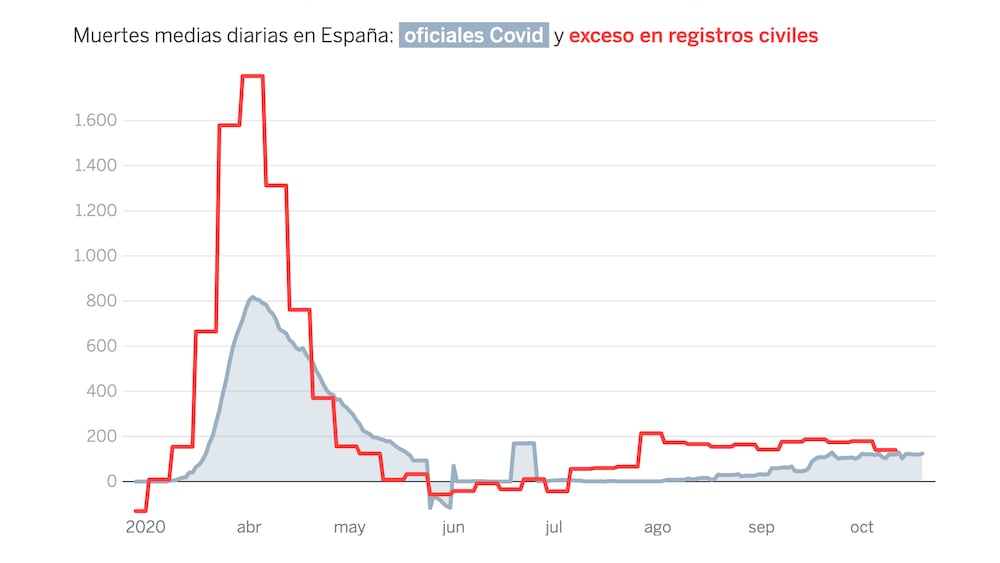During the second wave of coronavirus in Spain, 13,800 more deaths have been observed than the previous year.
In the last month, the excess is almost 5,000 deaths.
These are data published by the National Institute of Statistics (INE) based on the information collected by civil registries.
A part of that excess could have been due to the heat, but it does not seem to be the case: the Carlos III Health Institute attributes 1,950 deaths this year to high temperatures, which are the same that it attributed last year.
The graph shows the difference between the official death figures from coronavirus, according to the Ministry of Health, and the excess that is observed in civil registries.
Different factors can explain this discrepancy.
On the one hand, the ministry's protocol only considers deaths confirmed with a diagnostic test, but the people who die without testing, contrary to what happened in March, should be very few.
Another possibility is that the information released by the ministry is out of date or incomplete.
The data on excess deaths collected by the INE make it necessary to look at the official figures with concern: are they still having problems?
We know that the SiViES system, through which the autonomous communities communicate the data published by Health, accounts for half of the covid admissions of those reported by the hospitals themselves.
A similar problem could explain part of the difference between the deaths of the ministry in SiViES and those of the excess of the INE.
A third option is that the excess includes deaths from other pathologies.
Patients who have not been diagnosed in these months of crisis or who have received worse treatment.
Those deaths would be seen as an excess, but not in the official statistics of deaths from coronavirus, of course.
They would also be anomalous deaths, which cannot be attributed to the covid-19 disease, but to the health crisis that the virus has caused.
In addition, we know that deaths grow year by year around 0.8%.
This would explain a part of the excess that is observed in the INE data: since July about 800 deaths and for the whole year around 3,000.
The evolution since March
The graph shows the daily evolution of official deaths from coronavirus (ministry) and the excess observed in civil registries compared to the previous year (INE):
The highlight of the graph is the first wave: an excess of 47,000 deaths that was recorded in the spring.
There it can also be seen that the official figures were late.
Civil registries counted thousands of deaths in March that were only added later.
The INE statistics, which has been published every two weeks since June, shows how the Ministry of Health continued to count deaths in May and June that according to the records had occurred earlier.
A peak is also observed in early August.
So surely an undetermined volume of deaths from coronavirus coincided with the effects of a heat wave, which is a common source of mortality spikes.
According to the Carlos III Health Institute, high temperatures could have caused up to 2,000 deaths in two to three weeks around the beginning of August.
The figure is the same as last year, although then the peaks were in July.
Normality has not returned since that excess of early August.
More deaths have been recorded than in previous years, reaching 13,800 more than last year.
That number brings the excess observed since March to almost 62,000 deaths.
According to the INE figures, that would be the bill for this crisis, although the official number of deaths from covid only counts 34,200.
Deaths by communities
The impact of the second wave is also seen by autonomies: the majority of autonomous communities have excesses of more than 10%.
The table shows the excess observed in their civil records with respect to the previous year (in absolute terms, percentage and per 100,000 inhabitants).
Official deaths according to Health are also included.
All these figures are even worse if we go back to March.
For every three people from Madrid who should have died under normal conditions, this year five have died.
This proportion has been three for every two Castilian-Manchegos or seven for every five Catalans.
These data confirm that the excess of deaths registered during the current crisis has no comparison with anything that has occurred in recent years.
In 2019, some 2,000 deaths were attributed to the heat peaks and the previous one about 800. In January 2019 there was also an outbreak of influenza, which represented perhaps an excess of 3,000 deaths.
But none of those numbers is comparable to the 58,000 excess deaths recorded since March.
Excess mortality in other countries updated every two weeks
According to the data collected by the specialized website Our World In Data, from the University of Oxford, this year Spain would have one of the worst excesses of deaths among thirty countries, along with other countries such as Italy, the United Kingdom, the United States, Belgium or the Netherlands.









